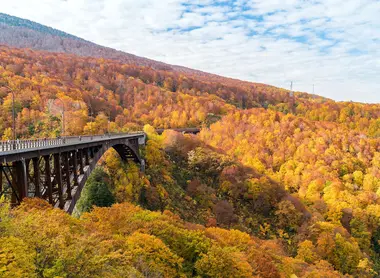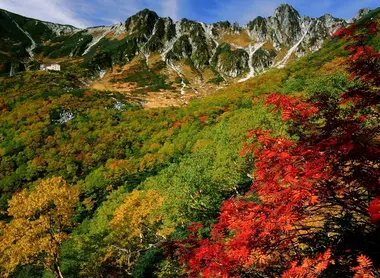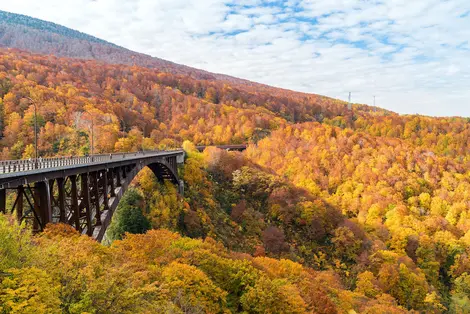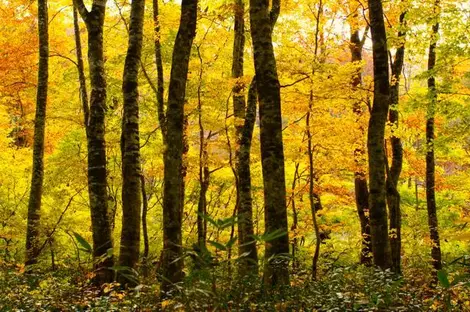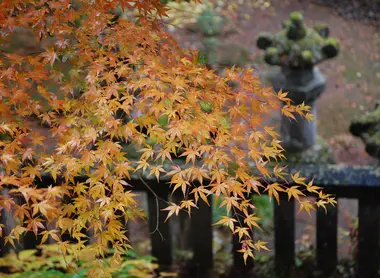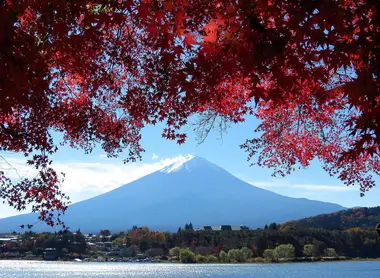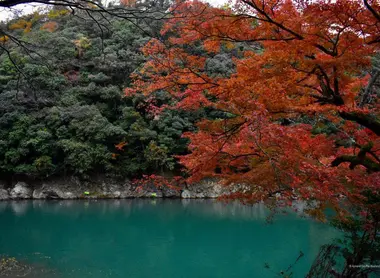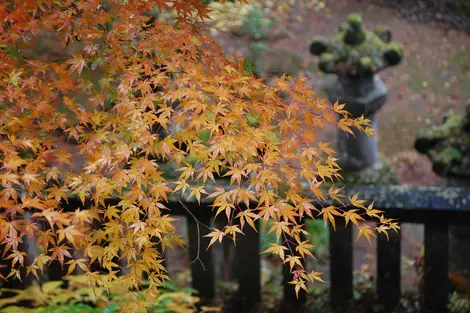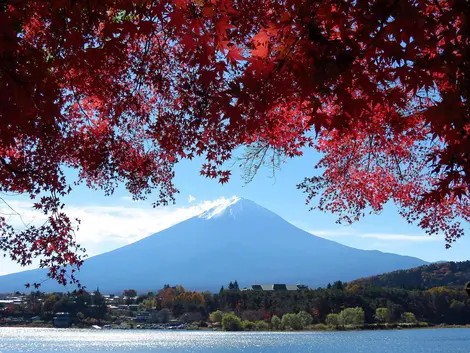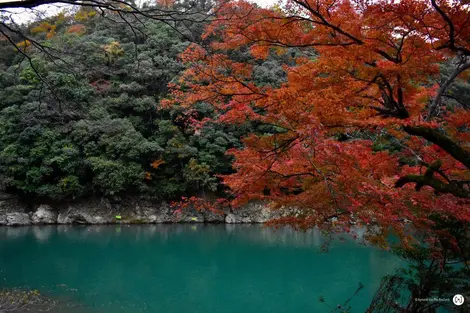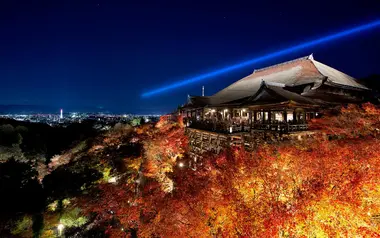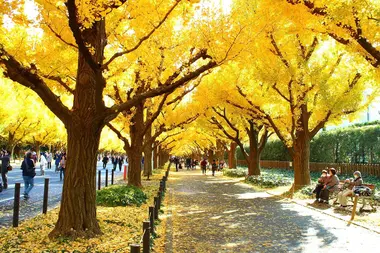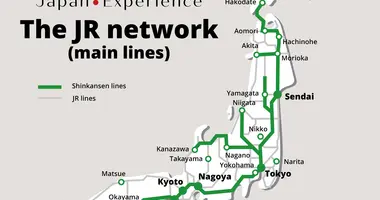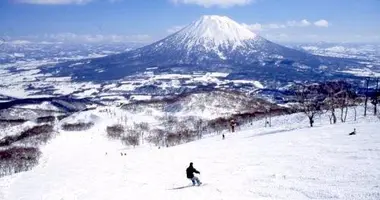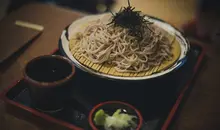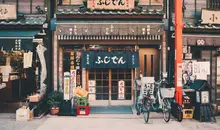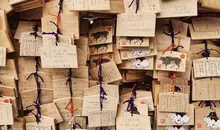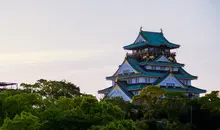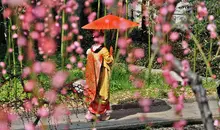Kōyō: autumn travel in Japan
- Published on : 17/01/2020
- by : G.L. / J.R.
- Youtube
Kōyō, the alter-ego of hanami in fall
Japanese autumn offers an extraordinary natural spectacle called Kôyô (紅葉), characterized by the changing color of the leaves that adorn the landscape in red, orange and yellow. This season, considered ideal for discovering Japan for the first time, runs from late September to mid-December, depending on the region. Kôyô represents the autumnal equivalent of Hanami (cherry blossom) and invites you to contemplate nature in transformation. Less crowded than spring, this period combines natural beauty, pleasant weather and authentic cultural experiences.
Understanding Kôyô: cultural significance and importance in Japan
Kôyô is a natural phenomenon: as autumn temperatures rise and the days shorten, the chlorophyll in tree leaves dries up, turning from green to red and orange before falling. From this phenomenon, Japan has derived a particular sense of contemplation that relates as much to Buddhist spirituality (as the reddening of the leaves reminds us that life is ephemeral) as to the beliefs of Shintoism, a belief in nature and its forces (for whom nature is inhabited by divine forces).
In Japanese, the term 紅葉 can be pronounced in two different ways. Momiji refers specifically to the red-tinted leaves of maple trees, while Kôyô represents the natural process by which all trees change color in autumn. This linguistic distinction reflects the finesse with which the Japanese perceive and celebrate nature's transformations.
It was from the Heian period (794-1185, marked by the designation of Kyoto as imperial capital) that the Japanese aristocracy developed a passion for Kôyô. The contemplation of autumn colors became a popular pastime, and even a quest: the term momijigari, literally "the hunt for red leaves", was coined to designate this time of year favored by aesthetes, who organized forest excursions accompanied by refined picnics and poetic declamations.
Kôyô calendar: when to go in different regions of Japan
Momijigari has lasted through the centuries, and is now an eagerly-awaited event for many Japanese, who are kept on their toes by weather forecasts that indicate to the day the best time to contemplate the autumn leaves, depending on the region. This phenomenon, known as koyo zensen (紅葉前線) or "red leaf front", enables us to accurately predict the progression of Kôyô across the archipelago.
The Kôyô season follows a north-south course across the Japanese archipelago, beginning in the northern regions and at high altitude:
- Late September to mid-October: Hokkaido, particularly around Sapporo and in Daisetsuzan National Park, the first place where Kôyô appear.
- Mid-October to early November: Tohoku (Sendai, Aomori), Nord-Chubu (Nagano, Kanazawa) and Nikko, where golden birches and larches add golden touches to the landscape.
- Mid-November to early December: Tokyo and Kanto, the whole of Kansai (Kyoto, Osaka, Nara) and southern Japan(Fukuoka, Kagoshima).
For autumn 2024, the Japan Meteorological Corporation's weather forecasts predict color peaks slightly later than the usual averages, due to a particularly long summer and persistent warm winds:
- Sapporo: November 8
- Sendai: November 22
- Tokyo: December 5
- Kyoto: December 18
The forecasts also distinguish between the appearance of red foliage on maples and yellow foliage on ginkgo trees, which occurs a few days earlier, e.g. around November 26 for Tokyo. These periods represent the Kôyô peaks, when autumn colors are at their most vibrant.
Must-see destinations for autumn colors
If you're looking for the full Kôyô experience, here are the most famous destinations across the Japanese archipelago:
Kyoto and Kansai
Kyoto is undoubtedly the best place to admire momiji, with its many temples nestled in a natural setting:
- Tofuku-ji: Famous for its Tsutenkyo bridge and hundreds of maple trees creating a carpet of bright red colors.
- Kiyomizu-dera: Offering panoramic views of the city and spectacular night-time illuminations in season.
- Kodai-ji: Known for its sublime autumn illuminations highlighting the garden and its maple trees.
- Arashiyama: A must-see district offering magnificent views of the colorful hills and tranquil river.
In Osaka, the castle and its park provide an ideal setting for admiring the Kôyô, with a striking contrast between the historic architecture and the flamboyant maple trees.
Tokyo and surrounding area
Japan's capital also offers many places to enjoy the autumn colors:
- The great Yoyogi and Shinjuku Gyoen parks, veritable oases of greenery in the heart of the metropolis.
- Rikugien Garden, famous for its autumn illuminations in Rikugi-en Park, where the reflections of illuminated maple trees on the water create an enchanting atmosphere.
- Icho Namiki Avenue, near Meiji-Jingu stadium, planted with hundreds of golden-leaved ginkgo biloba trees.
- Mount Takao, the perfect nature getaway just an hour from Tokyo, with the added bonus of a view of Mount Fuji on a clear day.
Nikko, about two hours north of Tokyo, is also a prime destination for admiring the Kôyô in a sumptuous natural setting, with its UNESCO-listed temples and mountainous landscapes.
Other regions
Beyond the best-known destinations, other regions offer spectacular autumn panoramas:
- In the Japanese Alps: Kamikochi, an alpine valley with breathtaking scenery, particularly beautiful when the larch trees turn golden in autumn.
- Around Mount Fuji: Lake Kawaguchiko, offering incomparable views of Fuji framed by red maples .
- Hokkaido: Daisetsuzan National Park, the first place where kôyô appear, with its spectacularly colorful mountains and forests.
- In Tohoku: Lake Towada and Oirase Gorge, one of the most impressive landscapes in the north, where the river flows through a blazing forest.
To discover other lesser-known but equally magnificent places, check out our article on 5 unusual places to admire autumn leaves.
Momijigari experience: Kôyô traditions and activities
Momijigari (紅葉狩り), literally "the hunt for red leaves", is much more than a simple observation of nature. It's a genuine cultural tradition that invites contemplation and meditation. Here's how to make the most of this experience:
Hikes and contemplative walks
The most authentic way to practice momijigari is to venture out into nature to admire the changing colors. Many hiking trails through mountains and forests are particularly popular during this season. The Japanese generally take a few days, with family or friends, to perpetuate this "hunt" for the beautiful and ephemeral.
This tradition echoes the Japanese concept of mono no aware (物の哀れ), a sensitivity to the ephemeral beauty of things and the gentle melancholy of their inevitable disappearance. Watching the leaves at their peak before they fall, we meditate on the transience of life and the beauty that lies in this impermanence.
Light-up at night
Many parks, gardens and temples offer special evening illuminations during the Kôyô season. These "light-ups" create a magical atmosphere by illuminating red maples and golden ginkgo trees. It's a different way to enjoy the autumn colors, but also a way to avoid the daytime crowds.
Among the sites offering remarkable illuminations are Kyoto's Kiyomizu-dera temple, Tokyo's Rikugien Garden and Osaka Castle. These events are generally held from mid-November to early December, coinciding with peak leaf color.
Cruises and panoramic views
For a different perspective, some rivers offer special cruises during the Kôyô season, allowing you to admire the flamboyant scenery from the water. Such is the case at Arashiyama, near Kyoto, where you can cruise on the Hozugawa River, surrounded by autumn-colored mountains.
Similarly, cable cars and observatories offer breathtaking panoramic views of colorful forests. Mount Takao near Tokyo, Mount Rokko in Kobe, and Mount Kurama north of Kyoto are particularly recommended for these panoramic views.
Flavours and culinary specialities of Japanese autumn
Autumn in Japan is also known as "minori no aki" (autumn harvest season), because it's harvest time. Japanese gastronomy, always attentive to the seasons, offers specific dishes that celebrate autumnal flavors.
Fruits and vegetables in season
- The Japanese sweet potato (satsuma imo サツマイモ) is omnipresent in autumn. Yaki imo, a naturally sweet, melt-in-the-mouth roasted sweet potato, is a comforting snack sold by street vendors.
- Chestnuts (kuri 栗) are in the spotlight, especially in kuri gohan, a rice cooked with chestnuts that absorb their natural sweetness.
- Persimmon and nashi (Japanese pear) are the emblematic fruits of autumn. Nashi has a light, refreshing taste and a crunchy texture, while persimmon can be eaten fresh or dried (hoshigaki).
Mushrooms and other delicacies
Mushrooms are particularly prized in autumn, including :
- Matsutake 松茸, a rare and expensive mushroom with a delicate, sought-after fragrance. Often cooked simply to preserve its flavor, it is the star ingredient of dobin mushi, a soup served in a small teapot.
- Ginnan 銀杏, ginkgo biloba seeds, used in dishes such as chawan mushi (egg flan) or yose nabe (Japanese fondue).
Seasonal fish
Autumn is also the ideal season to enjoy certain fish:
- Sanma サンマ, a long, slender fish that is ideally cooked just grilled and salted, accompanied by a slice of lemon and grated daikon.
- Saba サバ, a mackerel that reaches its best flavor in autumn, often marinated in vinegar or boiled with ginger and miso.
- Aji 鯵, light-smelling horse mackerel, prepared as sashimi or simply grilled with salt (shio yaki).
Sweets and pastries
Japanese pastries are also inspired by the motifs and flavors of autumn:
- Momiji manju, small maple leaf-shaped cakes traditionally filled with red bean paste, typical of the Hiroshima region.
- Tsukimi dango, mochi dumplings prepared for the mid-autumn festival (tsukimi) when the full moon is observed.
- More contemporary pastries incorporating the flavors of chestnut, sweet potato or persimmon.
These autumnal specialties bear witness to the Japanese desire to preserve and sublimate the natural aromas of seasonal produce, in keeping with the culinary philosophy that seeks to restore the true taste of food.
Practical tips for planning your trip during the Kôyô season
To make the most of the autumn season in Japan, here are a few practical tips to help you organize your trip:
Timing and reservations
Book your accommodation well in advance, especially in Kyoto, where establishments often sell out months before the Kôyô season. Ideally, plan your reservations 6 months in advance, or even longer for the most popular hotels.
To follow the evolution of autumn colors and adjust your itinerary according to weather forecasts, consult specialized websites that provide regular updates on the progress of Kôyô. The Japan Guide website publishes detailed autumn color reports every year.
Avoid the crowds
The Kôyô season attracts many tourists, both Japanese and foreign. For a calmer experience:
- Visit popular sites on weekdays rather than weekends to avoid crowds of locals.
- Arrive early in the morning at the most popular tourist sites, such as Arashiyama or the Kyoto temples.
- Plan excursions outside the major cities on weekends.
- Take advantage of night-time illuminations, which are generally less crowded than daytime visits.
Transport and travel
To get around the archipelago efficiently and follow the progress of the Kôyô from north to south:
- Consider buying a Japan Rail Pass if you plan to visit several regions.
- In Kyoto, the bus network can be very saturated during the high season. Travel early in the morning or in the evening.
- For more isolated sites, check public transport schedules in advance, which may be less frequent in rural areas.
Clothing and equipment
Autumn in Japan generally offers a pleasant climate with moderate temperatures, although these can vary considerably depending on the region and altitude:
- You'll need layered clothing to cope with the temperature variations between morning and afternoon.
- For mountain hikes, pack warm, waterproof clothing, as temperatures can drop rapidly.
- Don't forget your camera and extra batteries to immortalize these exceptional landscapes.
Photographing Kôyô: the best spots and techniques
Capturing the ephemeral beauty of autumn leaves is a real passion for many photographers, amateurs and professionals alike. Here are a few tips on how to get the most memorable shots:
Must-see spots
In addition to the sites already mentioned, there are a number of places that offer particularly photogenic compositions:
- The Tsutenkyo bridge at Tofuku-ji temple in Kyoto, where maple trees create a veritable red ocean below.
- The Korankei valley near Nagoya, less well known to foreign tourists but a favorite with Japanese photographers.
- The reflections of maple trees in Lake Kawaguchiko, with Mount Fuji in the background.
- Tokyo University's ginkgo alley, perfectly aligned and reflected on modern facades.
Technical tips
To bring out the autumnal colors in your photos:
- Favour the "golden hour", that period just after sunrise or before sunset, when the golden light intensifies the colors of the leaves.
- For close-ups of individual leaves, use a shallow depth of field to create a blurred background that highlights details and textures.
- Look for natural contrasts: red leaves against blue sky, reflections in water, or juxtaposition with traditional architecture.
- For night-time illuminations, use a tripod to avoid motion blur, and experiment with long exposures.
Secret spots and less-frequented locations
Avoid the crowds and still get unique shots:
- Katsuo-ji temple near Osaka, a "hidden gem" brimming with maple trees but little known on the tourist circuit.
- The Mitake-san valley, about two hours from Tokyo, offers superb hikes through colorful forests.
- In Kyoto, explore smaller, lesser-known temples such as Enko-ji or Shinnyo-do, which offer magnificent gardens without the crowds of the more famous sites.
For more inspiration, explore our specific guides: Kyoto, 5 places to admire autumn leaves, Kôyô in Tokyo's parks, Autumn in Nikko and 5 unusual places to admire autumn leaves.
Japanese autumn offers an unforgettable experience that combines natural beauty, cultural traditions and unique flavors. Unlike the more fleeting spring hanami, Kôyô extends over a longer period, giving you more time to contemplate and appreciate this emblematic season. Whether you're a photography enthusiast, a hiking enthusiast, or simply looking for an authentic cultural immersion, traveling in Japan during autumn will provide you with colorful and lasting memories.
